
Real help. Real fast.
Call or text (650) 215-6464
Most replies within minutes · Mon–Fri 8–5 PT
Or [email protected] 24/7

Call or text (650) 215-6464
Most replies within minutes · Mon–Fri 8–5 PT
Or [email protected] 24/7

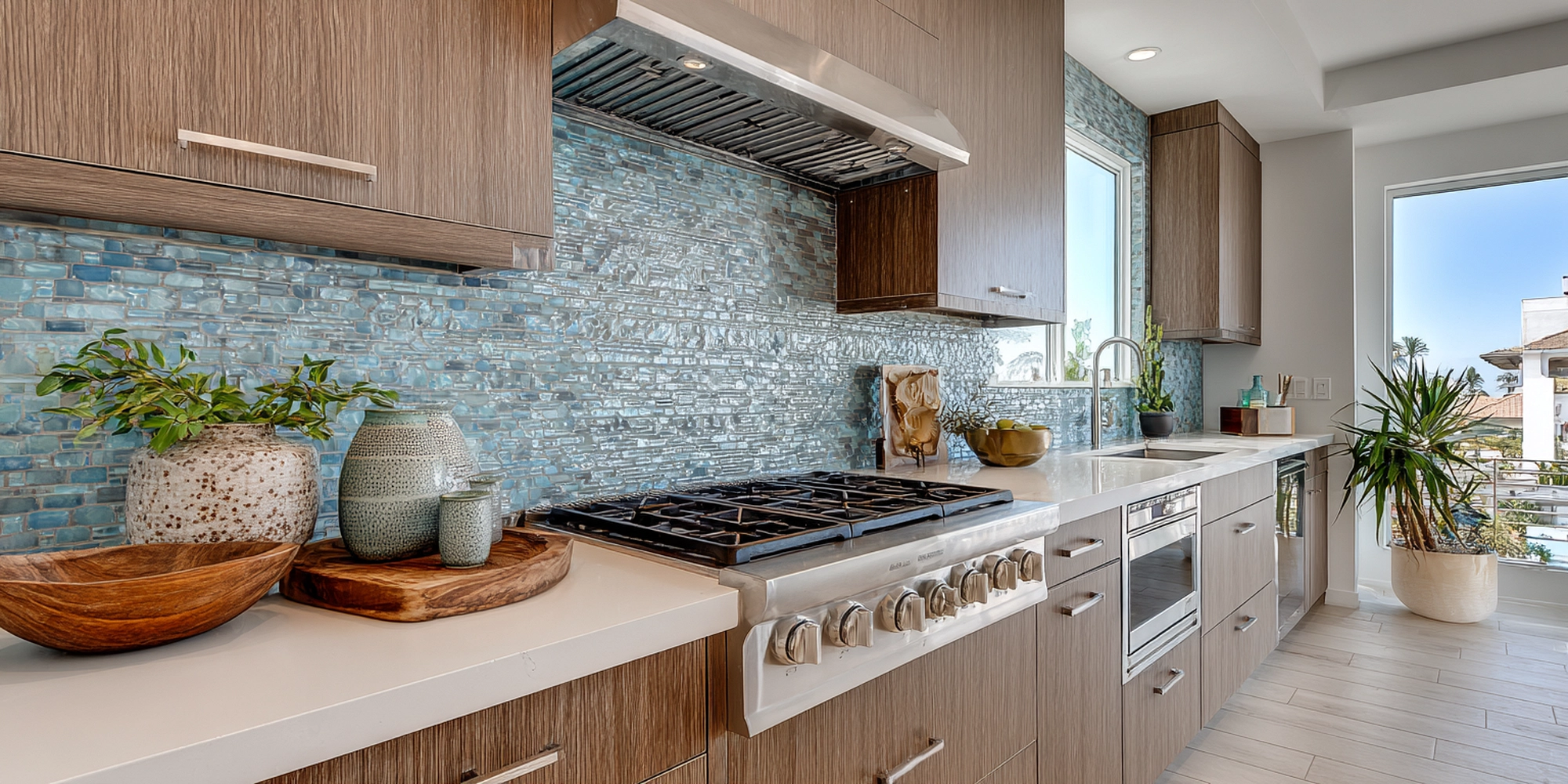
Summary: A well-designed kitchen backsplash is beyond a functional element that protects your walls from splatters and stains. It’s an opportunity to showcase your style, enhance the overall aesthetic of your kitchen, and develop a symmetric look that ties together your countertops, cabinets, and appliances.
However, achieving a seamless transition between your backsplash tile and countertop can be challenging. It requires careful planning and attention to detail.
In this comprehensive guide, we’ll explore the intricacies of the countertop to backsplash transition, discussing the pros and cons of different installation methods, and providing expert tips and techniques for you to make a wiser choice.
Whether you’re a homeowner working on your kitchen renovation or an interior designer seeking to create stunning spaces for your clients, this article will equip you with the knowledge and inspiration you need to master the art of backsplash tile installation.
About the Author: Elchin, co-founder of Solidshape, brings over 20 years of design experience. He’s consulted on hundreds of projects—from malls to luxury homes—and is known for helping clients make smart, stylish tile choices.
The countertop-to-backsplash transition refers to the point where your kitchen countertop meets the backsplash tile. This transition reflects in the functionality and aesthetics of your kitchen design.
Let’s dig deeper into it.
From a practical standpoint, the backsplash protects your walls from moisture, grease, and food splatters, which can cause damage and discoloration over time. A properly installed backsplash acts as a barrier, preventing these substances from seeping into the wall and causing long-term issues.
Aesthetically, the backsplash is an opportunity to introduce color, texture, and pattern into your kitchen design. The right backsplash tile can complement your countertop, enhance the overall style of your space, and create a striking focal point that draws attention and sparks conversation.
The significance of a proper transition between the countertop and backsplash can’t be overstated. The right transition creates a balanced and polished look, giving the impression of a well-thought out and professionally executed design.
On the other hand, a poorly planned or executed transition can result in gaps, uneven edges, or water infiltration, detracting from the beauty and functionality of your kitchen.
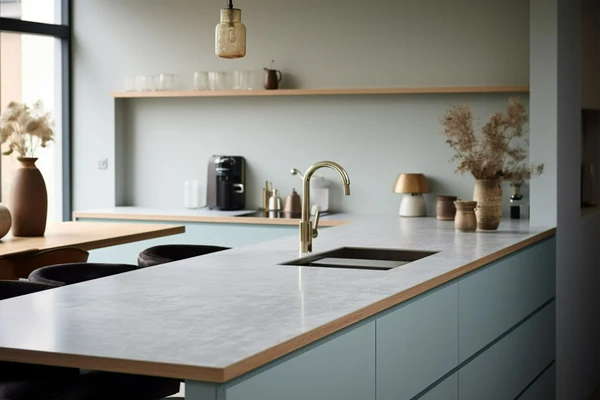
A common confusion homeowners and designers have while planning a kitchen backsplash is whether the tile should sit directly on the countertop or be installed slightly above it.
Either of these approaches has pros and cons and the best choice ultimately depends on various factors, such as the countertop material, tile size and thickness, and design preferences.
To ensure you make a wise choice, we have outlined the pros and cons when installing backsplash tile on and above the countertops.
| Pros | Cons |
| -Creates a premium, sophisticated look -Prevents water from seeping behind the countertop -Easier to clean and maintain | -Can be more challenging to install -Requires a perfectly level countertop -May not be suitable for heavy or thick tiles. |
| Pros | Cons |
| -Creates a premium, sophisticated look -Prevents water from seeping behind the countertop -Easier to clean and maintain | -Can be more challenging to install -Requires a perfectly level countertop -May not be suitable for heavy or thick tiles. |
There is no hard and fast rule on whether backsplash tile should sit on the countertop. Nevertheless, most industry professionals recommend leaving a small gap – about 1/8″ to 1/4″ – between the countertop and the tile.
This gap allows for expansion and contraction due to temperature changes, prevents the tile from cracking or popping loose, and provides a space for caulk or grout to create a water-resistant seal.
When deciding whether your backsplash tile should sit on the countertop or be installed slightly above it, there are several key factors to consider. These include the countertop material, the size, thickness, and weight of your chosen backsplash tile, and your personal design preferences.
Taking these elements into account will help you make an informed decision that results in a beautiful, functional, and long-lasting backsplash.
The material of your countertop can play a significant role in determining the best placement for your backsplash tile. Some materials, such as granite or quartz, are more prone to slight variations in level due to their natural composition and the fabrication process. These inconsistencies can make it difficult to achieve a perfectly flush transition between the countertop and backsplash tile.
In cases where the countertop surface is not perfectly level, installing the backsplash tile slightly above the countertop may be the better option. This approach allows for a small gap between the countertop and tile, which can accommodate any unevenness in the surface and prevent the tile from cracking or popping loose over time.
Alternatively, smoother, more uniform countertop materials like engineered quartz or solid surface may be better suited for a seamless installation, where the backsplash tile sits directly on the countertop. These materials typically have a more consistent surface level, making it easier to achieve a seamless, gap-free transition.
The size, thickness, and weight of your chosen backsplash tile can also influence the decision of whether to install it directly on the countertop or slightly above it. Larger, thicker, or heavier tiles may require a more substantial support system to ensure a stable and long-lasting installation.
In these cases, installing the backsplash tile above the countertop may be more practical. You can create a stronger foundation for the tile and reduce the risk of cracking or shifting over time by leaving a small gap between the countertop and tile. This gap also allows using a thicker bed of mortar or adhesive, offering additional support for heavier tiles.
Conversely, smaller, thinner, and lighter tiles may be more suitable for a flush installation directly on the countertop. These tiles require less support and can be installed using a thinner layer of adhesive, making it easier to achieve a flawless, gap-free transition.
Ultimately, the choice between a seamless or slightly raised backsplash comes down to your taste and the overall design style you want to achieve in your kitchen. Both options have merits and can create a beautiful, functional backsplash when installed correctly.
A flush installation, where the backsplash tile sits directly on the countertop, creates a sleek, seamless appearance that can give your kitchen a modern, minimalist feel. This approach works particularly well with smaller tiles or mosaic patterns, as it creates an uninterrupted visual flow between the countertop and backsplash.
On the other hand, installing the backsplash tile slightly above the countertop can add depth and dimension to your kitchen design. The small gap between the countertop and tile creates a subtle shadow line that can enhance the visual interest of your backsplash and make it a more prominent feature in the room. This approach can work well with larger tiles or more textured finishes, as it highlights the unique characteristics of the tile.
When deciding on the placement of your backsplash tile, consider your overall kitchen design, the style of your cabinets and countertops, and your personal preferences. You may also want to consult with a professional tile installer or designer to get expert advice on which option would work best for your specific situation.
Solidshape can be your one-stop tiling marketplace for kitchen backsplashes and countertops. Browse our extensive collection with various sizes, shapes, and design patterns that meet your expectations.
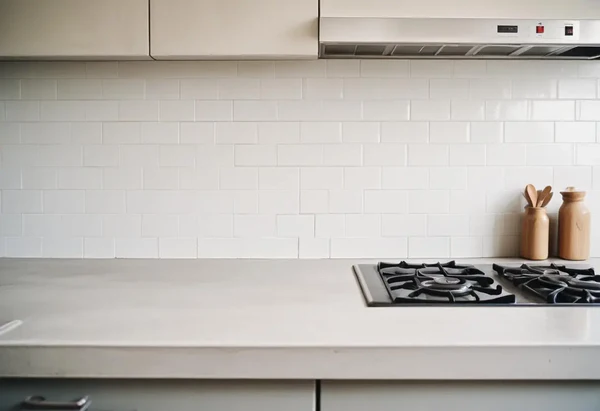
Achieving an ideal transition between your backsplash tile and countertop requires careful planning, attention to detail, and the use of proper installation techniques.
Here are some expert tips to help you create a flawless, professional-looking transition:
Ensuring a gap for the expansion and contraction of tiles helps in creating a water-resistant seal. It also allows some space for caulk or grout. Experts recommend leaving a 1/8″ to 1/4″ gap between the countertop and backsplash tile.
To maintain a consistent gap along the length of your countertop, use spacers between the tiles and the countertop. Spacers come in various sizes and materials, such as plastic or rubber, and can be easily removed once the tile adhesive has been set.
Once the tile is installed and the adhesive has cured, the gap between the tile and countertop should be filled with a high-quality, mildew-resistant caulk or grout. It prevents water infiltration and ensures a finished look.
If you install your backsplash tile directly on the countertop, ensuring a level and stable surface is paramount. Any unevenness or inconsistencies in the countertop can cause the tile to crack, pop loose, or create an unsightly, uneven transition.
Use a straight edge or level to guide your tile placement to achieve a flush and even overlap. Start at the bottom row and work your way up, using spacers to maintain a consistent gap between tiles. If necessary, use a tile leveling system to ensure a perfectly flush surface.
After the tile adhesive has cured, seal the seam between the tile and countertop with a high-quality, mildew-resistant caulk. This step is essential for preventing water and debris from seeping behind the tile and causing damage to your walls or countertop.
Schluter strips and bullnose tiles are designed to create a clean, finished edge along the transition between your backsplash and countertop. These transition strips not only provide a decorative element but also help protect the edges of your tile from chipping or cracking.
Schluter strips and bullnose tiles come in a variety of materials, colors, and finishes, allowing you to choose an option that complements your backsplash tile and overall kitchen design. Some popular materials include stainless steel, aluminum, and PVC, each offering its unique features and durability.
To install a Schluter strip or bullnose tile, apply a thin layer of tile adhesive along the edge of the countertop, then press the transition strip firmly into place. Use a level to ensure a straight, even installation, and allow the adhesive to cure completely before grouting or caulking the seam.
Installing a backsplash can be a messy process, and it’s essential to take steps to protect your countertop from damage during the installation process.
Here are some common risks and protective measures to keep in mind:
Tools, tiles, and debris can easily scratch, chip, or crack your countertop surface if proper precautions are not taken.
Grout and tile adhesives can cause stains or etching on porous countertop materials like marble or limestone if left to sit on the surface for too long.
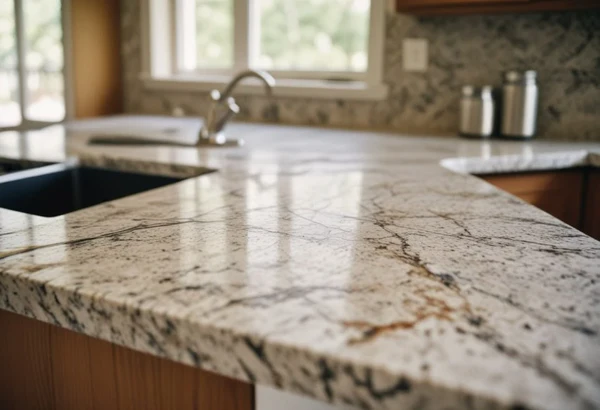
Before beginning your backsplash installation, consider applying a temporary protective film or cover to your countertop. These products, such as self-adhesive plastic sheets or heavy-duty kraft paper, can help shield your countertop from scratches, spills, and debris.
In addition to a protective film, you can use a physical barrier, such as a strip of cardboard or foam, between your countertop and the first row of tiles. This barrier helps prevent direct contact between the tile and countertop, minimizing the risk of damage.
Prior to installing your backsplash, thoroughly clean your countertop and apply a high-quality sealer, especially if you have a porous stone surface. A sealer helps repel stains and makes cleanup easier if any grout or adhesive comes into contact with the countertop.
Creating a cohesive and visually stunning kitchen requires careful consideration of how your backsplash and countertop will work together.
Try these design tips to achieve a harmonious and stylish setting:
Depending on your design goals, you can either match your backsplash closely with your countertop for a monochromatic impression or create contrast by selecting complementary colors or patterns.
For example, a white marble countertop paired with a soft gray subway tile backsplash creates a classic, coordinated look, while a black granite countertop with a bold, colorful mosaic tile backsplash offers a striking, eye-catching contrast.
When selecting your backsplash and countertop materials, aim to create a balanced and visually appealing combination. If your countertop features a busy pattern or strong veining, opt for a simpler, more subdued backsplash to avoid overwhelming the space.
Conversely, if your countertop is a solid color or has a subtle pattern, you can choose a more intricate or bold backsplash design to add visual interest.
Extending your backsplash tile to the ceiling or upper cabinets creates a flawless look that draws the eye upward and makes your kitchen feel taller and more spacious.
This approach works particularly well in smaller kitchens or those with low ceilings, as it helps to elongate the space visually.
Continuing your backsplash tile around windows, open shelving, or other features in your kitchen, helps to create a unified, polished look. It ensures that your backsplash becomes an integral part of the overall design rather than an afterthought.
The size of your backsplash tile can have a significant impact on the overall aesthetics of your kitchen.
Larger tiles, such as 4″x8″ or 4″x12″ subway tiles, can make a small kitchen feel more spacious and open. On the contrary, smaller tiles, like 1″x1″ mosaics or penny rounds, can add intricate detail and visual interest to a larger space.
Some of the most popular backsplash tile shapes and patterns include classic subway tiles, elegant herringbone layouts, and intricate mosaic designs.
When selecting your tile shape and pattern, consider the style of your kitchen (e.g., traditional, modern, farmhouse) and choose an option that complements your overall design vision.
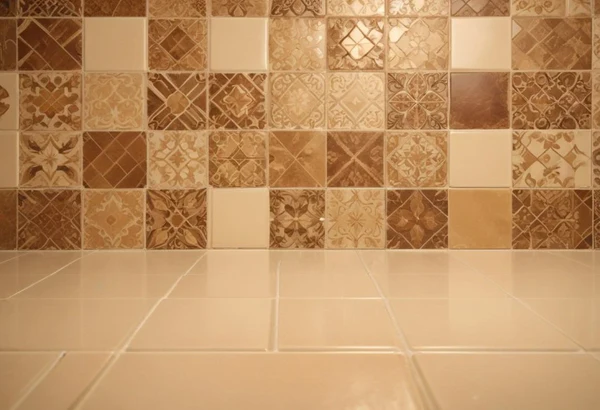
At Solidshape, we understand the importance of creating a flawless and visually stunning transition between your backsplash and countertop. That’s why we offer an exclusive collection of premium backsplash tiles, designed to help you achieve the kitchen of your dreams with ease and confidence.
You will find backsplash tiles crafted from the finest materials, including durable porcelain, elegant ceramic, and luminous glass. It ensures your backsplash is beautiful and meets the demands of daily use.
We have assimilated various colors, patterns, and finishes to suit any design style, from classic and timeless to bold and contemporary. Be it for a sleek, monochromatic mood or a vibrant, eye-catching statement, our collection has the perfect tile to bring your vision to life.
Find the perfect backsplash tile that complements the kitchen countertop and showcases your unique taste. Explore Solidshape’s luxurious backsplash tiles collection.
Installing your backsplash before your new countertop can lead to sizing and alignment issues. It’s best to install your countertop first, ensuring a proper fit and a seamless transition to your backsplash. This approach allows for more precise measurements and a professional, polished look.
The key rule for kitchen backsplashes is to create a seamless, functional, and visually appealing transition between the countertop and the wall. This involves selecting materials that complement your countertop, ensuring proper installation techniques, and maintaining a consistent grout line for a professional, polished look.
Classic subway tiles in neutral colors like white, cream, or soft gray are timeless for kitchen backsplashes. These simple yet elegant tiles offer versatility and enduring style, making them a perfect backdrop for a variety of design aesthetics, from traditional to contemporary.
Choose from Solidshape’s range of subway tiles for your kitchen backsplashes.